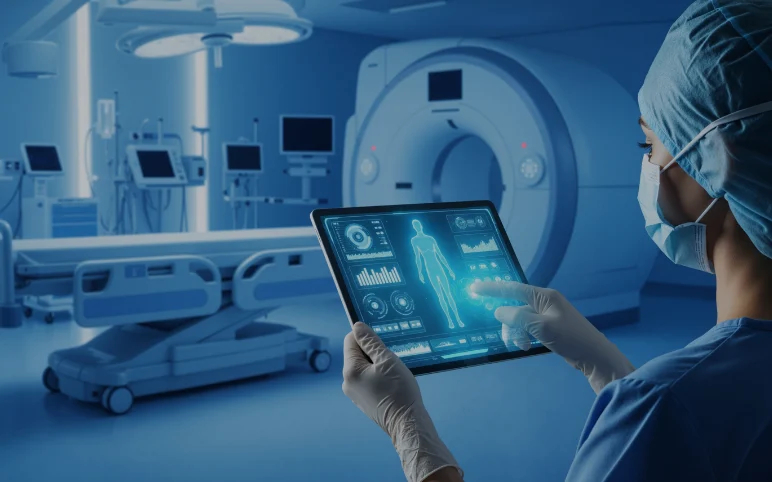FDA Approves Nyxoah’s Genio® System for Treating Obstructive Sleep Apnea
On August 08, 2025, Nyxoah SA, a medical technology company that developed breakthrough treatment alternatives for Obstructive Sleep Apnea (OSA) through neuromodulation, announced that the U.S. Food and Drug Administration (FDA) had approved the Genio system for a subset of patients with moderate to severe OSA with an Apnea-Hypopnea Index (AHI) between 15 and 65.
Genio represented a different approach to hypoglossal nerve stimulation (HGNS) for the treatment of OSA. Its unique design utilized bilateral stimulation and offered patients a leadless, full-body 1.5T and 3T MRI compatible, non-implanted battery solution, powered and controlled by a wearable component. The wearable component was fully upgradable, providing Genio patients with access to the technology without requiring additional surgeries for updates or battery replacements.
“Today marks a defining moment for Nyxoah and for U.S. patients suffering from OSA. With the FDA’s marketing approval of the Genio system, we are proud to bring this innovative therapy to the U.S. market,” commented Olivier Taelman, Nyxoah’s Chief Executive Officer. “Our mission has always been to make sleep simple for OSA patients by offering them a solution that empowers better sleep. We look forward to the successful execution of our U.S. commercialization strategy.”
“The Genio system’s approval represents a major addition to the treatment options available to physicians treating patients with OSA,” said Colin Huntley MD, Associate Professor, Department of Otolaryngology Head & Neck Surgery, Thomas Jefferson University. “This unique bilateral stimulation technology has demonstrated consistent efficacy across all sleeping positions, including the challenging supine position, while maintaining an excellent safety profile.”
The Genio system’s FDA approval was supported by high-quality, differentiated safety and efficacy data from the Company’s DREAM pivotal trial. The DREAM study met both its primary and secondary endpoints, demonstrating an AHI responder rate of 63.5% and an Oxygen Desaturation Index responder rate of 71.3%, with an overall median AHI reduction of 70.8%. Additionally, 82.0% of all DREAM subjects experienced AHI scores dropping to 15 or lower.
Importantly, the DREAM study showed that Genio was efficacious regardless of a patient’s sleeping position and, to the Company’s knowledge, was the only therapy with such clinical evidence in a large, multicenter, prospective clinical study using data from a full-night polysomnography. This served as a critical differentiator, as on average, people slept in a supine position between 35% and 40% of the night. The DREAM study measured position-specific outcomes and demonstrated a 66.6% median AHI reduction while patients slept in a supine position, even though the number of airway obstructions could double in this position. This reduction compared favorably to the 71.0% reduction in AHI observed while patients slept in a non-supine position.
As per DelveInsight’s “Neuromodulation Devices Market Report”, the neuromodulation devices market was valued at USD 5.71 billion in 2023, growing at a CAGR of 8.95% during the forecast period from 2024 to 2030 to reach USD 9.56 billion by 2030. The demand for neuromodulation devices is primarily driven by the growing prevalence of neurological disorders and the increasing number of patients suffering from chronic pain. Additionally, increasing research and development activities, along with collaborations among key players, are significantly contributing to market growth. The rising aging population further compounds this demand, as older adults are more susceptible to neurological conditions and chronic pain. These factors collectively position the neuromodulation devices market for positive growth during the forecast period from 2024 to 2030.
DeepSight™ Technology Received the First FDA 510(k) Clearance for NeedleVue™ LC1 Ultrasound System
On August 13, 2025, DeepSight Technology, a medical imaging pioneer, announced that it had received U.S. Food and Drug Administration (FDA) 510(k) clearance for its NeedleVue™ LC1 Ultrasound System.
This clearance marks an important step forward in DeepSight’s development of its NeedleVue™ and OnPoint™ technologies that will work in tandem with the NeedleVue™ LC1 Ultrasound System to transform image-guided procedures. “This is a foundational milestone in our mission to deliver crystal clear, sub-millimeter level guidance inside the body,” said Nader Sadrzadeh, CEO of DeepSight. “We have developed the next generation sensor technology for enhancing ultrasound where it what matters most: clear visualization, procedural efficiency, and user confidence. We’re just getting started and look forward to building on this achievement as we expand our clinical and commercial momentum in the months ahead.”
As per DelveInsight’s “Ultrasound Devices Market Report”, the global ultrasound devices market was valued at USD 6.76 billion in 2023, growing at a CAGR of 6.82% during the forecast period from 2024 to 2030 to reach USD 10.05 billion by 2030. The ultrasound devices market is witnessing positive growth owing to the rising incidence of severe chronic diseases such as cardiovascular, urology, and others, further rapid technological developmental activities, growing awareness for early disease detection, and increasing geriatric population across the globe who are more susceptible to developing chronic disorders, and rising adoption owing to no radiation exposure, thereby contributing to the growth of the ultrasound devices market during the forecast period.
U.S. Military Study Identified TITAN CSR® Retractor as Top Surgical Retractor for Deployed Trauma Care
On August 12, 2025, Advanced Surgical Retractor Systems, Inc. (ASR Systems) announced that its flagship product, the TITAN CSR® retractor, had been identified as the top-performing retractor system in a Department of Defense–funded study evaluating surgical retraction platforms for forward-deployed surgical teams.
The findings were presented at the Military Health System Research Symposium (MHSRS) 2025, the DoD’s premier scientific meeting on military medicine. The study, “Comparison of Self-Retaining Retractor Systems for Use in Forward-Deployed Surgical Teams,” evaluated multiple commercially available systems, including the TITAN CSR® retractor, Bookwalter®, Alexis™, and Balfour based on exposure quality, ease of use, portability, and suitability for damage control surgery in austere environments.
Statistically significant results from the study demonstrated that the TITAN CSR® retractor
provided the greatest surgical exposure of any retractor tested, measured by the visualized surface area of the abdominal cavity. Surgeons rated the TITAN CSR® retractor’s exposure performance 4.9 out of 5.0 nearly a perfect score and a critical advantage for life-saving operations where every centimeter of visibility mattered.
Additionally, assembled and deployed faster than the Bookwalter®, a complex system requiring a table attachment and multiple components. Combat hospitals often lacked the standard operating room beds with side rails needed to mount the Bookwalter®, meaning it was frequently not even an option for military surgeons. The TITAN CSR® retractor eliminated this limitation, and in high-acuity trauma cases, reducing setup time helped achieve control of hemorrhage faster and saved valuable minutes in the operating room.
Furthermore, received the highest overall perception of use among all systems tested, based on surgeon and surgical team ratings of setup simplicity, adaptability to different procedures, stability during use, and overall effectiveness in achieving optimal exposure.
“The TITAN CSR® retractor has been rigorously evaluated by the Department of Defense, with the study’s significant findings showing it delivers the greatest surgical exposure, fastest setup, and highest overall surgeon satisfaction among systems tested,” said Dr. Ramon Cestero, trauma surgeon, military veteran, and inventor of the TITAN CSR® retractor. “It is in active use at military facilities as well as Level 1 trauma centers across the U.S. and Canada, where civilian surgeons have reported the same benefits in their own high-acuity cases speed, exposure, and simplicity that directly impact patient outcomes.”
As per DelveInsight’s “Surgical Retractors Market Report”, the global surgical retractors market was valued at USD 2.33 billion in 2023, growing at a CAGR of 5.80% during the forecast period from 2024 to 2030, to reach USD 3.26 billion by 2030. The increase in demand for surgical retractors is primarily attributed to the rising number of surgeries in the world. In addition, rise in the old age population, escalating prevalence of various chronic disorders such as cardiovascular disorders, neurological disorders, and others, availability of specialized and application-specific retractors in the market, and recent product launches, among others, is projected to boost the global surgical retractors market during the forecasted period.
Myra Vision Secured FDA Approval to Initiate US IDE Study in Glaucoma
On August 12, 2025, Myra Vision, a Shifamed portfolio company, announced that the U.S. Food and Drug Administration (FDA) had issued a conditional approval letter for its Investigational Device Exemption (IDE) application to initiate the ADAPT study. The prospective, nonrandomized, open-label trial was designed to evaluate the safety and effectiveness of Myra’s Calibreye™ Titratable Glaucoma Therapy™ (TGT) Surgical System in up to 70 refractory glaucoma patients, with a 12-month primary effectiveness endpoint.
“Lowering IOP is the only known treatment to prevent optic nerve damage and preserve vision for glaucoma patients. Current therapies are not always successful at lowering IOP, and safer approaches are needed,” stated David S Friedman, MD, PhD, MPH, Director of the Glaucoma Service at Mass Eye and Ear at Mass General Brigham in Boston and medical monitor for the trial. “I look forward to kicking off this important study to see if the successful early clinical experience with the Calibreye System is demonstrated in a larger clinical trial. For lowering eye pressure, the Calibreye technology offers a potentially safer solution for patients.”
“This FDA approval to initiate our ADAPT study marks a significant milestone for our company as we advance our mission to deliver innovation to glaucoma care,” stated Robert Chang, President and Chief Executive Officer of Myra Vision. “We look forward to initiating our clinical program in the United States and evaluating our technology’s potential to address a critical unmet need for these underserved patients.”
The leading cause of irreversible blindness, glaucoma affects an estimated 80M people worldwide. There is no cure for glaucoma, so patients and their caregivers seek to reduce or eliminate disease progression through intraocular pressure (IOP) control. Traditional glaucoma surgery, including trabeculectomy and tube shunt implants, and more recently developed less invasive surgical devices, do not offer adjustability to meet individual clinical needs.
According to DelveInsight’s “Micro Invasive Glaucoma Surgery (MIGS) Devices Market Report”, the Micro Invasive Glaucoma Surgery (MIGS) Device market was valued at USD 406.55 million in 2023, growing at a CAGR of 13.34% during the forecast period from 2024 to 2030 to reach USD 972.26 million by 2030. The demand for microinvasive glaucoma surgery devices is primarily being boosted by the growing prevalence of glaucoma. Furthermore, the increasing lifestyle disorders such as diabetes and hypertension double the chances of causing glaucoma, leading to vision loss and blindness, thereby boosting the market of micro-invasive glaucoma surgery devices. Additionally, increasing technical innovation in product development, such as less invasiveness and more effectiveness, are one of the other key drivers that are responsible for contributing to the positive growth of the micro-invasive glaucoma surgery device market during the forecast period from 2024 to 2030.
HistoIndex Marked Another Step Forward with FibroSIGHT™ Plus: Introduced AI-based Quantitative Analysis in Fibrosis Assessment
On August 11, 2025, HistoIndex, a pioneering leader in digital pathology solutions for chronic liver disease, announced the launch of FibroSIGHT™ Plus, its second Laboratory Developed Test (LDT) available in the United States. Building on the foundation of FibroSIGHT™, which had debuted just months earlier, FibroSIGHT™ Plus introduced an additional feature of automated quantitative analysis of fibrosis, a key advancement that enabled more consistent and precise characterization at diagnosis and supported tracking of fibrosis in patients with Metabolic Dysfunction-associated Steatohepatitis (MASH).
At the core of FibroSIGHT™ Plus was qFibrosis®, HistoIndex’s proprietary AI-driven algorithm. By leveraging stain-free Second Harmonic Generation (SHG) imaging of MASH liver biopsies, qFibrosis® automatically quantified multiple fibrosis-related collagen architectural and morphological features detected by SHG in various spatial zones of a liver biopsy and translated them into a single value or stage for fibrosis. The result expressed fibrosis on a continuous scale, rather than in discrete categories. This provided more detailed insights into disease severity and offered clinicians a sensitive tool to better characterize individual patients at diagnosis and to monitor subtle changes in their disease over time.
“Having worked with HistoIndex for many years, I have witnessed firsthand the value that Second Harmonic Generation imaging brings to fibrosis assessment in MASH clinical trials, with highly sensitive and consistent detection and quantification of fibrosis in liver biopsies. Automated solutions like FibroSIGHT™ Plus represent the future of liver pathology. The ability to detect incremental changes in fibrosis with this level of precision is exactly what we need to guide earlier and more targeted interventions in MASH,” said Dr. Naim Alkhouri, MD, Chief Academic Officer at Summit Clinical Research and the Director of the Steatotic Liver Disease Program at the Clinical Research Institute of Ohio.
According to DelveInsight’s “Liver Disease Diagnostics Market Report”, the global liver disease diagnostics market was estimated to grow at a CAGR of 5.97% during the forecast period from 2024 to 2030. The demand for liver disease diagnostics is primarily being boosted by the increasing number of people with liver diseases, the rise in alcohol consumption, and bad eating habits, among others. Furthermore, the liver disease diagnostics market is anticipated to grow on account of a large number of ongoing research activities in this field, collaborations between healthcare providers, researchers, and industry players, and strategic partnership,s among others are going to contribute to the overall growth of the liver disease diagnostics market during the forecast period from 2024 to 2030.
Gentuity LLC Announced Agreement to Collaborate with GE HealthCare to Expand Access to Advanced Intravascular Imaging Platform
On August 07, 2025, Gentuity LLC, a Massachusetts-based medical technology company specializing in next-generation intravascular imaging devices, announced an agreement with GE HealthCare to collaborate on commercial activities. The collaboration was intended to enhance the availability, adoption, and functionality of complementary imaging solutions for interventional cardiology.
As part of the agreement, Gentuity and GE HealthCare planned to jointly pursue co-marketing initiatives and technical integration of their respective technologies. GE HealthCare also explored opportunities to expand access to Gentuity’s innovative products through its U.S. distribution network. These products included the high-frequency OCT Imaging System: A mobile console powered by machine learning technology, offering rapid setup and detailed imaging capabilities.
Vis-Rx® Prime Micro-Imaging Catheter: The world’s smallest imaging catheter at 1.8F, designed for comprehensive vessel imaging before and after percutaneous coronary intervention (PCI) procedure
“We are thrilled at the opportunity to expand our relationship with GE HealthCare and look forward to bringing our advanced imaging solutions to a broader range of healthcare providers,” said Desmond Adler, President of Gentuity. “Our industry best serves our physicians and patients when we thoughtfully combine complementary technologies in a way that amplifies their individual impact, and we see this collaboration as an important enabling step in that direction.”
As per DelveInsight’s “Interventional Cardiology Devices Market Report,” the interventional cardiology devices market was valued at USD 13.21 billion in 2023, growing at a CAGR of 6.53% during the forecast period from 2024 to 2030, to reach USD 19.31 billion by 2030. The demand for interventional cardiology devices is primarily being boosted by the growing prevalence of cardiovascular diseases (CVDs). The rising geriatric population, which is more prone to developing heart disease, and increasing R&D activities and technological innovations by key players to develop advanced devices are the key factors that are driving the growth of the interventional cardiology devices market during the forecast period from 2024 to 2030.



